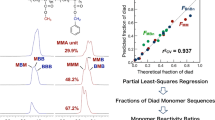Abstract
A novel generalized least square (GLS) estimator program was employed for determination of styrene (STY)/butyl acrylate (BA) reactivity ratios synthesized by solution copolymerization method. The monomer reactivity ratios as well as the 95 % individual confidence limits were determined by application of conventional linear methods like Finemann–Ross, Ezrielev–Brokhina–Roskin, Joshi–Joshi, Kelen–Tudos, modified Kelen–Tudos, extended Kelen–Tudos and Mao–Huglin. The estimation process was performed by applying techniques based on ordinary least square (OLS) and GLS approaches and the results were compared. The results showed a fairly good agreement between the experimental and calculated copolymer compositions. The model was then successfully validated through handling regression models with error terms that are heteroskedastic or autocorrelation, or both and clearly showed that the model was able to predict the reactivity ratios by accounting response error structure. Based on the copolymer compositions determined by 1H NMR, the reactivity ratios of STY and BA were found to be 0.886634 and 0.216369, respectively, by Mao–Huglin method through the GLS approach, and this new estimation method shows the best linear estimations for the monomer reactivity ratios. The present paper shows a new estimation integral approach for determining the monomer reactivity ratios by different conventional linear methods at low and high conversions in EViews software and the calculated values are discussed in terms of regression models.










Similar content being viewed by others
References
Kumar KR, Feroz S, Rao PR (2008) Reactivity ratios, thermal and di-electrical properties of 1,11 azobis (cyclohexanecarbonitrile) initiated nitrile copolymer. Asian J Res Chem 1:58–63
Bakhshi H, Zohuriaan-Mehr MJ, Bouhendi H, Kabiri K (2010) Emulsion copolymerization of butyl acrylate and glycidyl methacrylate: determination of monomer reactivity ratios. Iran Polym J 19:781–789
Fu Z, Fan Y, Fan Z (2011) Temperature-structure dependence of poly(1-octene-co-t-butyl acrylate) prepared by conventional free radical polymerization. Iran Polym J 20:223–235
Dubé M, Penlidis A, O’Driscoll KF (1990) Mathematical modelling of styrene/butyl acrylate copolymerization. Chem Eng Sci 45:2785–2792
Bradbury J, Melville H (1954) The copolymerization of butyl acrylate and styrene in benzene solution. Series A. Math Phys Eng Sci 222:456–470
Kaszas G, Földes-Berezsnich T, Tüdös F (1985) Solvatation von copolymeren untersuchungen an poly(styrol-co-butyl acrylate) und poly(styrol-co-butyl methacrylate)en. J Macromol Sci Chem 22:1571–1592
Ziaee F, Nekoomanesh M (1998) Monomer reactivity ratios of styrene-butyl acrylate copolymers at low and high conversions. Polymer 39:203–207
Fernández-García M, Fernández-Sanz M, Madruga EL, Cuervo-Rodriguez R, Hernández-Gordo V, Fernández-Monreal MC (2000) Solvent effects on the free-radical copolymerization of styrene with butyl acrylate. I. Monomer reactivity ratios. J Polym Sci Part A Polym Chem 38:60–67
Chambard G, Klumperman B, German AL (1999) Dependence of chemical composition of styrene/butyl acrylate copolymers on temperature and molecular weight. Polymer 40:4459–4463
Pazhanisamy P, Reddy B (2007) Copolymers of n-cyclohexylacrylamide and n-butyl acrylate: synthesis, characterization, monomer reactivity ratio and mean sequence length. Express Polym Lett 1:391–396
Hagiopol C, Frangu O (2003) Strategies in improving the accuracy of reactivity ratios estimation. J Macromol Sci Part A 40:571–584
Habibi A, Vasheghani-Farahani E, Semsarzadeh MA, Sadaghiani K (2003) A generalized least square model for the determination of monomer reactivity ratios in free radical copolymerization systems. Macromol Theory Simul 12:184–195
Koreisha S, Pukkila T (1990) A generalized least-squares approach for estimation of autoregressive moving-average models. J Time Ser Anal 11:139–151
Kaya E (2011) Copolymers of 4-methoxybenzyl methacrylate and isobornyl methacrylate: synthesis, characterization and determination of monomer reactivity ratios. J Chem Soc Pak 33:555–561
Ayaz N, Bezgin F, Demirelli K (2012) Polymers based on methacrylate bearing coumarin side group: synthesis via free radical polymerization, monomer reactivity ratios, dielectric behavior, and thermal stabilities. ISRN Polym Sci 2012:1–13
Finemann M, Ross SD (1950) The trimer of o-phthalonitrile. J Polym Sci 5:259–262
Ezrielev A, Brokhina E, Roskin E (1969) Analytical method for calculating copolymerization constants. Vysokomol Soedin A 11:1670–1680
Joshi R, Joshi S (1971) A new analytical solution of the binary copolymer composition equation and suggested procedure for deriving the monomer reactivity ratios. J Macromol Sci-Chem 5:1329–1338
Kelen T, Tüdős F (1974) A new improved linear graphical method for determining copolymerization reactivity ratios. React Kinet Catal L 1:487–492
Rangel–Rangel E, Torres CM, Koteich-Khatib S, Rincón L, López-Carrasquero F (2012) Copolymerizations of long side chain di n-alkyl itaconates and methyl n-alkyl itaconates with styrene: determination of monomers reactivity ratios by NMR. Rev Latin Am Metal Mat 32:79–88
Baruah SD, Sarmah D, Laskar NC (2011) Copolymers of bulky fumarate: synthesis and their properties. J Polym Res 18:225–233
Tüdos F, Kelen T, Földes-Berezsnich T, Turcsanyi B (1976) Analysis of the linear methods for determining copolymerization reactivity ratios. I. A new improved linear graphic method. J Macromol Sci-Chem 10:1513–1540
Mao R, Huglin MB (1993) A new linear method to calculate monomer reactivity ratios by using high conversion copolymerization data: terminal model. Polymer 34:1709–1715
Author information
Authors and Affiliations
Corresponding author
Rights and permissions
About this article
Cite this article
Ashenagar, S., Ziaee, F. Estimation of reactivity ratios of styrene/butyl acrylate copolymer by ordinary and generalized least square methods. Iran Polym J 22, 511–518 (2013). https://doi.org/10.1007/s13726-013-0147-1
Received:
Accepted:
Published:
Issue Date:
DOI: https://doi.org/10.1007/s13726-013-0147-1




